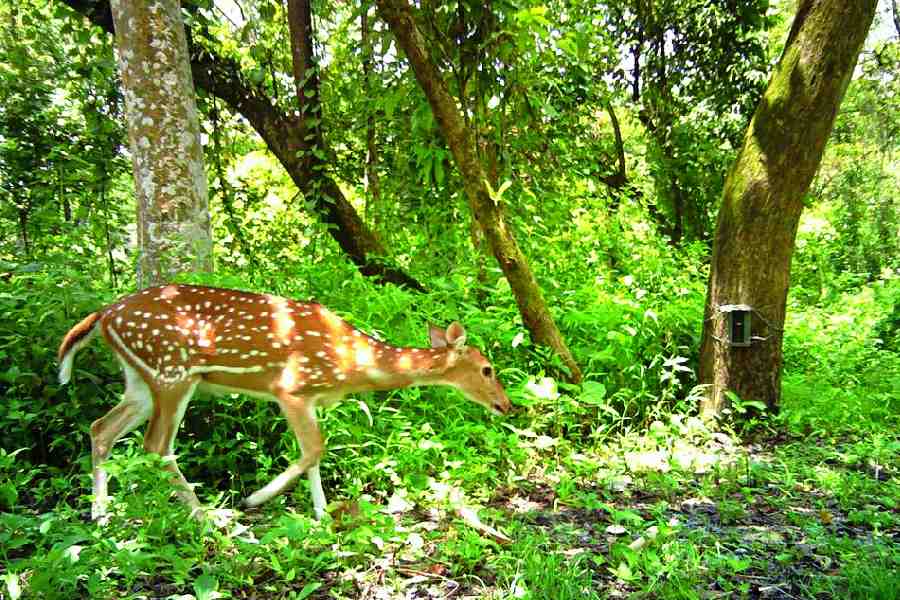Four soft-release centres for Cheetals are under construction in Jharkhand’s Palamu Tiger Reserve (PTR) for augmenting the prey base for predators, an official said.
A fifth one is in the process of being set up at Budha Pahad area, once a Maoist bastion, the official said.
Cheetals would be translocated at the soft-release centres from Betla area of the reserve and the initiative is expected to bring back tigers to PTR, the official said.
The PTR, one of the first nine tiger reserves of the country, which was teeming with tigers in the 1970s reported nil tigers in 2018.
A tiger was spotted in PTR in March 2023, after more than three years.
The state forest department has also decided to develop grassland and construct check dams on the foothills of Budha Pahad, located along Latehar and Garhwa districts, around 150 km from state capital Ranchi.
The foothills of Budha Pahad in Kutku range has been a tiger corridor between Jharkhand and Chhattisgarh since long.
Grassland development and construction of soft-release centre and check dam might boost the frequency of tiger movement in future in the region, which is close to Guru Ghasidas National Park (GGNP) in Chhattisgarh, an official said.
The GGNP connects Jharkhand and Madhya Pradesh and provides a corridor for tigers to move between Bandhavgarh in Madhya Pradesh and PTR in Jharkhand, he said.
"The National Tiger Reserve Authority (NTCA) has given its approval in-principle to our proposals. We have recently submitted fund requisition to NTCA for soft-release centre, grassland development and check dams on the foothills of Budha Pahad," PTR (North) deputy director Prajesh Jena told PTI.
The region has been infamous for Maoist activities but very soon it will be known as a wildlife centre, he said.
Budha Pahad, used by top Maoist leaders from Jharkhand, Chhattisgarh, Bihar, Odisha and Maharashtra as a shelter, was freed from the red rebels’ control by security forces after over three decades in September last year.
Jena said that the proposed soft-release centre at Budha Pahad would come up on 10 to 15 hectares, while grassland would be developed on 20 hectares.
About 15 check dams will be constructed to ensure water availability for wild animals in the region, he said.
NTCA had advised to set up small soft release centres in strategic places of the reserve.
"Constructions of four soft release centres are already underway in Chipadohar area and PTR south," he said.
PTR director Kumar Ashutosh told PTI, "Cheetal, one of major prey for tigers, is mainly concentrated in Betla area of the reserve. The population of spotted deer will be more than 5,000 and it needs to be spread out across the reserve areas through the soft-release centres. Cheetal from Betla region will be shifted to the soft-release centres in certain numbers and later they will be released in forest." Spread over 1,129 sq km, PTR, which was constituted in 1974 under Project Tiger, had 22 tigers in 1972, a former principal chief conservator of forest (wildlife), Jharkhand, Pradeep Kumar wrote in his book ‘Main Baagh Hoon’, which was published in 2016.
The reserve recorded its highest tiger population in 1995 with 71 tigers. Thereafter, the population of big cats started declining. There were 44 in 1997, 34 in 2002, 10 in 2010 and 3 in 2014, according to the book.
Of the 1,129.93 sq km area of PTR, 414.08 sq km is marked as core area (critical tiger habitat) and the remaining 715.85 sq km as the buffer zone. Of the total area, 226.32 sq km is designated as Betla National Park. In the buffer zone, 53 sq km is open for tourists.
A section of wildlife experts, however, criticised the move for grassland development, and construction of check dams and soft release centres at the foothills of Budha Pahad, describing it as a "waste of money".
"Poaching, cattle grazing and human disturbance are major reasons for the declining number of big cats in the reserve. The Forest department should first focus on controlling the factors. Tiger population doesn’t increase in a disturbed habitat," former state wildlife board member D S Srivastava told PTI.
He said the PTR authority had shifted 16 Sambars from Ranchi’s Bhagwan Birsa Biological Park to a soft-release centre in Baresanr area of the reserve in 2017.
"Even after five years, neither did the population of sambar increase at the soft-release centre nor any animal was released from it. It has been a failure, ” he said.
A total of 47 species of mammals and 174 species of birds, 970 species of plants, 17 species of grass and 56 species of medicinal plants have been identified in PTR, officials said.
PTI
Except for the headline, this story has not been edited by The Telegraph Online staff and has been published from a syndicated feed.











